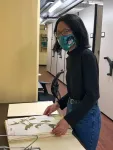Color blindness-correcting contact lenses
2021-03-03
(Press-News.org) Imagine seeing the world in muted shades -- gray sky, gray grass. Some people with color blindness see everything this way, though most can't see specific colors. Tinted glasses can help, but they can't be used to correct blurry vision. And dyed contact lenses currently in development for the condition are potentially harmful and unstable. Now, in ACS Nano, researchers report infusing contact lenses with gold nanoparticles to create a safer way to see colors.
Some daily activities, such as determining if a banana is ripe, selecting matching clothes or stopping at a red light, can be difficult for those with color blindness. Most people with this genetic disorder have trouble discriminating red and green shades, and red-tinted glasses can make those colors more prominent and easier to see. However, these lenses are bulky and the lens material cannot be made to fix vision problems. Thus, researchers have shifted to the development of special tinted contact lenses. Although the prototype hot-pink dyed lenses improved red-green color perception in clinical trials, they leached dye, which led to concerns about their safety. Gold nanocomposites are nontoxic and have been used for centuries to produce "cranberry glass" because of the way they scatter light. So, Ahmed Salih, Haider Butt and colleagues wanted to see whether incorporating gold nanoparticles into contact lens material instead of dye could improve red-green contrast safely and effectively.
To make the contact lenses, the researchers evenly mixed gold nanoparticles into a hydrogel polymer, producing rose-tinted gels that filtered light within 520-580 nm, the wavelengths where red and green overlap. The most effective contact lenses were those with 40 nm-wide gold nanoparticles, because in tests, these particles did not clump or filter more color than necessary. In addition, these lenses had water-retention properties similar to those of commercial ones and were not toxic to cells growing in petri dishes in the lab. Finally, the researchers directly compared their new material to two commercially available pairs of tinted glasses, and their previously developed hot-pink dyed contact lens. The gold nanocomposite lenses were more selective in the wavelengths they blocked than the glasses. The new lenses matched the wavelength range of the dyed contact lenses, suggesting the gold nanocomposite ones would be suitable for people with red-green color issues without the potential safety concerns. The researchers say that the next step is to conduct clinical trials with human patients to assess comfort.
INFORMATION:
The authors acknowledge funding from Khalifa University, Khalifa University - Korean Advanced Institute of Science and Technology Joint Research Center, Sandooq Al Watan LLC, Aldar Properties and the Engineering and Physical Sciences Research Council for a New Investigator Award (U.K.).
The paper is freely available as an ACS AuthorChoice article
here.
For more of the latest research news, register for our upcoming meeting,
ACS Spring 2021. Journalists and public information officers are encouraged to apply for complimentary press registration by emailing us at newsroom@acs.org.
The American Chemical Society (ACS) is a nonprofit organization chartered by the U.S. Congress. ACS' mission is to advance the broader chemistry enterprise and its practitioners for the benefit of Earth and its people. The Society is a global leader in providing access to chemistry-related information and research through its multiple research solutions, peer-reviewed journals, scientific conferences, eBooks and weekly news periodical Chemical & Engineering News. ACS journals are among the most cited, most trusted and most read within the scientific literature; however, ACS itself does not conduct chemical research. As a specialist in scientific information solutions (including SciFinder® and STN®), its CAS division powers global research, discovery and innovation. ACS' main offices are in Washington, D.C., and Columbus, Ohio.
To automatically receive news releases from the American Chemical Society, contact newsroom@acs.org.
Follow us:
Twitter | Facebook
[Attachments] See images for this press release:

ELSE PRESS RELEASES FROM THIS DATE:
2021-03-03
Land stores vast amounts of carbon, but a new study led by Cranfield University's Dr Alice Johnston suggests that how much of this carbon enters the atmosphere as temperatures rise depends on how far that land sits from the equator.
Ecosystems on land are made up of plants, soils, animals, and microbes - all growing, reproducing, dying, and breathing in a common currency; carbon. And how much of that carbon is breathed out (also known as ecosystem respiration) compared to how much is stored (through primary production) has impacts for climate change. ...
2021-03-03
Using the model organism Caenorhabditis elegans, researchers at the University of Cologne have developed an 'aging clock' that reads the biological age of an organism directly from its gene expression, the transcriptome. Bioinformatician David Meyer and geneticist Professor Dr Björn Schumacher, director of the Institute for Genome Stability in Aging and Disease at the CECAD Cluster of Excellence in Aging Research and the Center for Molecular Medicine Cologne (CMMC), describe their so-called BiT age (binarized transcriptomic aging clock) in the article 'BiT age: A transcriptome based aging clock near the theoretical limit of accuracy' in Aging Cell.
We are all familiar ...
2021-03-03
Alexandria, Va., USA -- The clinical picture of COVID-19 in various target organs has been extensively studied and described, but relatively little is known about the characteristics of oral cavity involvement. The study "Frequent and Persistent Salivary Gland Ectasia and Oral Disease After COVID-19" published in the Journal of Dental Research (JDR), investigated the presence and prevalence of oral manifestations in COVID-19 survivors.
Researchers at the Università Vita Salute San Raffaele, Milan, Italy, profiled the oral involvement in 122 COVID-19 survivors, hospitalized and followed up at a single referral visit after a median 104 days from ...
2021-03-03
Systemic fungal infections are much rarer than other illnesses, but they are potentially deadly, with limited options for treatment. In fact, fungi are becoming increasingly resistant to the few drugs that are available, and infections are growing more common. A cover story in Chemical & Engineering News, the weekly newsmagazine of the American Chemical Society, details how scientists are working to improve our antifungal arsenal.
At present, there are only four types of antifungal drugs approved by the U.S. Food and Drug Administration (FDA), and some infections are resistant to those drugs, making surgery ...
2021-03-03
Fields are covered with dandelions in spring, a very common plant with yellow gold flowers and toothed leaves. When they wither, the flowers turn into fluffy white seed heads that, like tiny parachutes, are scattered around by the wind. Taraxacum officinale, that is its scientific name, inspired legends and poems and has been used for centuries as a natural remedy for many ailments.
Now, thanks to a study conducted at the University of Trento, dandelions will inspire new engineered materials. The air trapping capacity of dandelion clocks submerged in water has been measured in the lab for the first time. The discovery paves the way for the development of new and advanced ...
2021-03-03
CLEMSON, South Carolina - Clemson University scientists have linked climatic fluctuations over the past one and a quarter-century with flower color changes.
Researchers combined descriptions of flower color from museum flower specimens dating back to 1895 with longitudinal- and latitudinal-specific climate data to link changes in temperature and aridity with color change in the human-visible spectrum (white to purple).
The study, which was published in the journal Proceedings of the Royal Society B, showed the change varied across taxa.
"Species ...
2021-03-03
PROVIDENCE, R.I. [Brown University] -- Humans have made a remarkable impact on the planet, from clearing forests for agriculture and urbanization to altering the chemistry of the atmosphere with fossil fuels. Now, a new study in the journal Nature reveals for the first time the extent of human impact on the global water cycle.
The study used NASA's Ice, Cloud and Land Elevation Satellite (ICESat-2) to assemble the largest ever dataset of seasonal water levels in more than 227,000 lakes, ponds and reservoirs worldwide. The data reveal that even though human-managed reservoirs comprise only a small percentage of all water bodies, they account for 57% of the total seasonal water storage changes globally.
"We ...
2021-03-03
A team from the Chinese Academy of Sciences and Cardiff University say they have found the strongest evidence yet of a "migration gene" in birds.
The team identified a single gene associated with migration in peregrine falcons by tracking them via satellite technology and combining this with genome sequencing.
They say their findings add further evidence to suggest genetics has a strong role to play in the distance of migration routes.
The study, published today in the journal Nature, also looks at the predicted effect of climate change on migration - and how this might interact with evolutionary factors.
The researchers tagged 56 Arctic peregrine falcons and tracked their journeys by satellite, following their annual flight distances and directions in detail.
They found the studied ...
2021-03-03
At the beginning of an immune response, a molecule known to mobilize immune cells into the bloodstream, where they home in on infection sites, rapidly shifts position, a new study shows. Researchers say this indirectly amplifies the attack on foreign microbes or the body's own tissues.
Past studies had shown that the immune system regulates the concentration of the molecule, sphingosine 1 phosphate (S1P), in order to draw cells to the right locations. The targeted cells have proteins on their surface that are sensitive to levels of this molecule, enabling them to follow the molecule's "trail," researchers say. S1P concentration gradients, for instance, can guide immune T cells to either stay in lymph nodes, connected glands in which these cells mature, or move into blood ...
2021-03-03
New research shows 64 countries cut their fossil CO2 emissions during 2016-2019, but the rate of reduction needs to increase tenfold to meet the Paris Agreement aims to tackle climate change.
This first global stocktake by researchers at the University of East Anglia (UEA), Stanford University and the Global Carbon Project examined progress in cutting fossil CO2 emissions since the Paris Agreement was adopted in 2015. Their results show the clear need for far greater ambition ahead of the important UN climate summit in Glasgow in November (COP26).
The annual cuts of 0.16 billion tonnes of CO2 are only 10 ...
LAST 30 PRESS RELEASES:
[Press-News.org] Color blindness-correcting contact lenses


